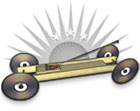Calculate Maximum Pulling Distance
Earth shattering secrets for building record setting and winning mousetrap cars and racers. Here you will find all the latest and greatest untold construction secrets so you can build your very own mousetrap vehicle.
Purpose
To determine the pulling distance and the mechanical advantage.
Equipment Needed
- Ruler (A caliper makes smaller measurements easier)
- Meter Tape
- Stopwatch (extension only)
Discussion
With mousetrap cars, the pulling distance is a measurement of how far a mousetrap powered car will be under the pulling force of the mouse trap. In this activity students will calculate how far their mousetrap car should be pulled and then compared to the actual pulling distance. The pulling distance does not tell the total distance that a mousetrap car will travel but only how far the vehicle will be under the force of the mouse trap's spring. The distance that a mousetrap car is being pulled under the force of the mouse trap's spring is directly proportional to the size of the drive wheels, the drive axle, and the length of the lever arm. The travel distance is inversely proportional to the size of the drive axle. What all this means is the following: the larger the drive wheel(s), the greater the pulling distance. The more string that can be pulled off the drive axle, the greater the pulling distance. The larger the drive axle, the shorter the pulling distance. In order to get more string wound around the drive axle, you can do one of the following: use a smaller diameter drive axle or extend the length of the mousetrap's lever arm and then place the trap further from the drive axle. The pulling distance is calculated from the number of turns that the drive wheel(s) make times the circumference of the drive wheel. The number of turns that a drive wheel makes depends on the length of string that can be pulling from the drive axle divided by the circumference of the drive axle. By putting the first two formulas together you can predict the pulling distance.
Distance = Turns * π d wheel
formula: pulling distance (Distance) is defined in the mathematical terms as the number of turns of the drive wheel (Turns) multiplied by the circumference of the drive wheel (d) or Pi times the drive wheel diameter [d].
Turns = String Length / πddrive axle
formula: the number of turns of the drive wheel (Turns) is defined in the mathematical terms as the length of string (String Length) pulled from the drive axle divided by the circumference of the drive axle (d) or Pi times the diameter of the drive axle [d].
Distance = (String Length * ddrive wheel) / ddrive axle
combined formulas: the pulling distance (distance) is equal to the length of string (String Length) pulled from the drive axle times the diameter of the drive wheels (d drive wheel) divided by the diameter of the drive axle (d drive axle). Pi cancels out of the formula and is not needed.
Step 1:
If the diameter of the drive axle is not know, use a caliper or micrometer to measure and calculate the average diameter of the drive axle. Calculate the average diameter of the drive axle by first measuring the drive axle without string on it and then by measuring it with string wound-up on the axle as it would normally be wound-up before a race. It is important that the string be wound evenly and not clumped. Add the two measurements together and then divide by 2. This will give you an average diameter of the drive axle. Calculate the average radius from the average diameter.
Ave Drive Axle Diameter = _____ meters

finding axle diameter: use a caliper to find the diameter of the drive axle.
Step 2:
Use a caliper or a ruler to measure the diameter of the drive wheel and record the diameters.
Drive Wheel Diameter = _____ meters

finding wheel diameter: use a ruler or caliper to find the diameter of the drive wheel.
Step 3:
Measure only the length of string that is normally pulled from the drive axle; in most cases, this is twice the lever arm length. Important: If there is more string than is actually pulled from the drive axle by the mouse trap's spring then make sure to measure only the amount of string that is pulled directly from the drive axle my the mouse trap.
String Length = _____ meters

measure string length: measure only the length of string pulled by the mouse trap from the drive axle.
Step 4:
Calculate the pulling distance by combining formulas from above and using the recorded data from steps 1-3.
Pulling Distance = (Turns * ddrive wheel) / ddrive axle
Step 5:
Calculate the mechanical advantage from the following formula.
IMA = ddrive wheel / ddrive axle
mechanical advantage: the mechanical advantage can be found by dividing the drive wheel diameter (d drive wheel) by the drive axle diameter (d drive axle).
Testing the Results
Test the accuracy of your calculations. Place the mousetrap vehicle at a start line, release the vehicle, and then follow the vehicle marking the exact point on the ground where the mouse trap stops pulling string from the drive axle; this point is not the total travel distance but the point where the mouse trap's spring is no longer pulling the string from the drive axle. Measure from the start line to the end of the pulling distance and then find the percent error.
Graphing the Results
Using data from other students vehicles,make a graph of Pulling Distance vs. Mechanical Advantage. Put "mechanical advantage" on the horizontal axis and 'pulling distances' on the vertical axis.
Analysis
Describe any relationship that might exist between wheel to mechanical advantage and pulling distance. Is the relationship directly proportional, explain.
Extension
If you know the original starting potential energy you can follow these steps to calculate the power output.
Step 1:
Using a stop watch, time your mousetrap vehicle over the pulling distance only.
time over pulling distance = _____ seconds
Step 2:
Us the following formula to calculate the power output.
P = PE / t
power output: power output if the rate at which work is being done. Using the original starting energy (joules) (found from the all wound-up activity), divide by the time (seconds) over the pulling distance and this is the power output in watts.
*Can't find what you're looking for? Ask Doc Fizzix »




